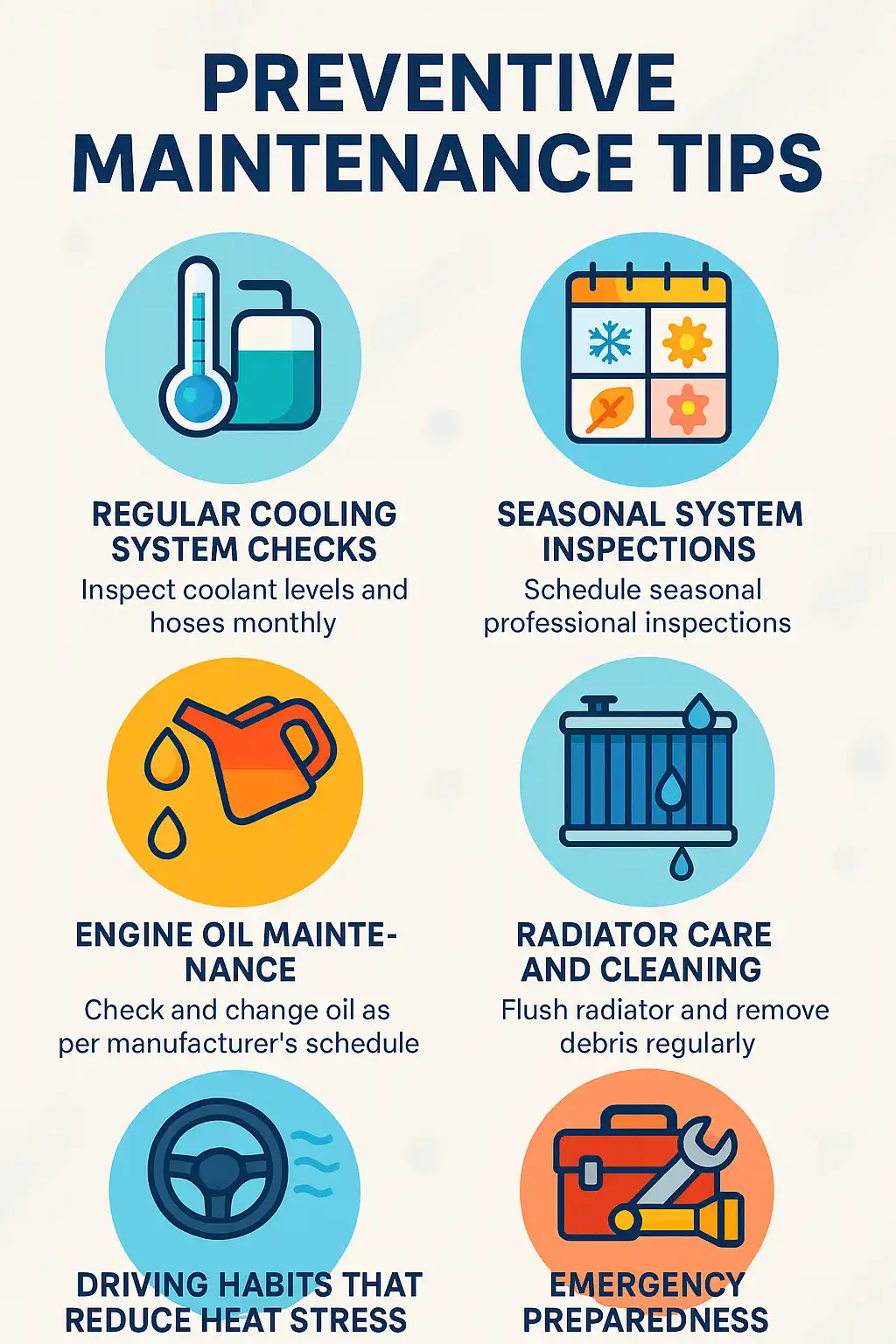Few things are as nerve-wracking as watching your car’s temperature gauge climb while you’re stuck in traffic or cruising down the highway. Overheating can turn a smooth ride into an expensive repair bill if not handled quickly. The good news? Understanding the common causes can help you act fast and avoid major damage.
Why is My Car Overheating?
A car usually overheats when the cooling system can’t remove heat from the engine efficiently. This could be due to low coolant, a leak, a faulty thermostat, a water pump failure, or even issues with the radiator or cooling fans. In most cases, the problem starts small, like a slow coolant leak, but can escalate quickly if ignored.
Common Causes of Overheating
1. Low Coolant Levels
Coolant is the lifeblood of your engine’s temperature control system. When levels drop too low—whether from evaporation, neglect, or a slow leak—the system can’t transfer heat effectively. This often starts with small symptoms like a slightly higher temperature reading before becoming a full-blown overheating incident.
2. Cooling System Leaks
Leaks can occur in the radiator, hoses, water pump, or even within the engine itself. A small drip under your car after parking might seem harmless, but if it’s coolant, it’s a sign that the system’s pressure and fluid levels are compromised.
- Faulty Thermostat
The thermostat regulates when coolant flows into the radiator. If it sticks closed, coolant can’t circulate, causing a rapid rise in temperature. This is one of the more common but less obvious causes, and it often requires a mechanic to diagnose. - Water Pump Malfunction
The water pump keeps coolant moving through the engine. When its impeller wears down or the pump fails, circulation slows or stops, leaving hotspots inside the engine. - Radiator & Fan Issues
Even if coolant is flowing, a clogged radiator or a broken fan can prevent heat from dissipating. Radiators can become blocked by rust, sediment, or debris, while fans may fail due to electrical issues or worn motors. - Low Engine Oil
Oil doesn’t just lubricate—it also helps disperse heat. Low or degraded oil can increase engine temperature by adding internal friction. - Head Gasket Failure
A blown head gasket can allow coolant to seep into the combustion chambers or oil passages, creating overheating and potentially catastrophic engine damage.
I still remember a summer road trip years ago when my old sedan started creeping toward the red zone on the gauge. The A/C was blasting, the sun was relentless, and I thought I could “just make it” to the next town. Big mistake. Within minutes, steam poured from under the hood. Turned out a small hose leak had drained enough coolant to trigger the overheating. It cost me a tow and a weekend of repairs—proof that catching the signs early can save a lot of money and stress.
Immediate Steps to Take if Your Car Overheats
Recognizing the Danger Signs
When your car begins to overheat, the first indication is often a rising temperature gauge or a warning light on the dashboard. You may also notice steam seeping from under the hood, a sweet smell from leaking coolant, or even a slight loss of power. These are not symptoms to push through; continuing to drive in this state risks permanent damage to the engine. Acting quickly is essential.
Pulling Over Safely and Shutting Down
The moment you suspect overheating, find a safe place to pull over. Choose a location away from traffic if possible and turn off the engine immediately. This pause allows the engine to stop generating heat and gives it a chance to begin cooling down. It’s important not to open the hood right away; depending on how hot the system is, scalding steam can cause serious burns. Waiting at least 20–30 minutes before inspecting under the hood is a good rule of thumb.
Using the Heater to Draw Away Heat
A counterintuitive but effective step is to turn your cabin heater to maximum and set the fan to high. This process draws heat away from the engine and disperses it into the passenger compartment. While it’s not the most comfortable thing to do—especially in warm weather—it can buy you enough time to safely reach a better stopping point or allow the engine temperature to drop more quickly while stationary.
Checking Coolant Levels Safely
Once the engine has cooled, you can check the coolant reservoir to see if the level has dropped below the “min” mark. If it’s low and you have coolant on hand, topping it up can restore some functionality to the cooling system. In an emergency, clean water can be used as a temporary measure until you can get the proper coolant mixture. Always make sure the engine is fully cool before opening the radiator cap; opening it when hot can cause pressurized fluid to spray out.
Inspecting for Obvious Leaks or Issues
With the hood open and the engine off, look for visible signs of trouble—puddles under the car, wet hoses, or a frayed belt. If the radiator fan isn’t spinning when the engine is warm, there may be an electrical or mechanical fault preventing it from running. While some of these issues can be temporarily managed on the side of the road, others require professional repair.
Deciding Whether to Drive or Tow
If topping off the coolant seems to stabilize the temperature and there are no major leaks, you might be able to carefully drive to a nearby mechanic. Keep the heater running and watch the gauge closely. If the temperature starts climbing again, pull over and call for roadside assistance. Driving too far with an overheating engine can warp metal components, blow the head gasket, or seize the engine entirely. In those cases, the cost of a tow is a small price compared to the repair bill for catastrophic engine damage.
Avoiding Quick Fix Temptations
It’s tempting to ignore an overheating episode if the car “seems fine” after cooling down, but the underlying cause rarely resolves itself. Overheating is almost always a symptom of a deeper issue—be it a leak, blockage, or failed component. Temporary fixes, such as adding coolant without finding the leak, might get you home but will not solve the problem. A proper inspection is always necessary to prevent a repeat incident.
Preparing for the Unexpected
Having an emergency kit in your vehicle can make dealing with overheating much easier. Keeping a bottle of coolant, a jug of water, gloves, and a flashlight can turn a roadside crisis into a manageable delay. Planning for the possibility means you’re less likely to make risky decisions in the heat of the moment—literally and figuratively. By responding decisively, you not only protect your car from serious damage but also ensure your own safety until help arrives or repairs can be made.
When to Call a Mechanic
Knowing When DIY Isn’t Enough
Some overheating issues can be addressed temporarily on your own, but many require professional diagnostics. If you notice persistent high temperatures, unexplained coolant loss, or recurring overheating despite topping off fluids, it’s time to involve a mechanic. Ignoring these signs often leads to more severe engine problems.
Clear Warning Signs to Seek Help
- Steam from under the hood even after cooling down
- Milky oil on the dipstick (a possible sign of head gasket failure)
- Coolant pooling beneath the vehicle after each drive
- Radiator fan not operating when engine is hot
- Temperature spikes shortly after starting the engine
- Burning smells from the engine bay
What a Mechanic Will Check
A qualified mechanic will start with a cooling system pressure test to detect leaks, followed by thermostat, radiator, and water pump inspections. They may also perform a chemical test for exhaust gases in the coolant—an indicator of head gasket issues. Electrical components like fan relays and temperature sensors will also be evaluated.
Typical Repair Costs
The cost of repairs depends on the cause and severity of the problem. While topping up coolant is inexpensive, replacing a water pump or radiator can cost significantly more. Here’s a general breakdown of common overheating-related repairs:
| Repair Type | Typical Cost Range (USD) |
| Coolant top-up | $20 – $50 |
| Thermostat replacement | $150 – $300 |
| Radiator replacement | $400 – $1,000 |
| Water pump replacement | $300 – $750 |
| Head gasket replacement | $1,500 – $3,000+ |
Why Early Intervention Saves Money
- Prevents small leaks from escalating into major failures
- Reduces the risk of warping engine components from excessive heat
- Keeps repair costs lower by addressing the root cause early
- Extends the lifespan of your engine and related systems
Preventive Maintenance Tips
According to the Federal Highway Administration, preventive maintenance can extend vehicle life by up to 50% and significantly reduce emergency repair costs.

Regular Cooling System Checks
Staying ahead of overheating problems starts with a consistent maintenance routine. Inspect the coolant reservoir at least once a month and before long trips. Make sure the coolant is clean and at the recommended level. Replacing coolant according to your vehicle manufacturer’s schedule helps prevent corrosion and scale buildup that can block the radiator or heater core.
Seasonal System Inspections
- Before summer, ensure radiator and cooling fans are working efficiently to handle higher temperatures.
- Before winter, verify the coolant mixture has the proper antifreeze ratio to prevent freezing and ensure adequate boil-over protection.
- Spring and fall – Inspect belts and hoses for cracks or soft spots that could fail under temperature fluctuations.
Engine Oil Maintenance
- Change oil at the recommended intervals using the manufacturer-specified grade.
- Check oil levels regularly, as low oil can increase friction and contribute to overheating.
- Look for signs of oil contamination (milky appearance), which could indicate internal leaks.
Radiator Care and Cleaning
- Periodically clean the radiator fins using low-pressure water to remove dirt, bugs, and debris.
- Ensure there’s no physical damage that could impede airflow.
- Have a mechanic flush the system every 1–2 years to remove sediment and deposits.
Driving Habits That Reduce Heat Stress
- Avoid excessive idling in traffic without airflow over the radiator.
- Shift to neutral when stopped for long periods to reduce engine load.
- Limit towing heavy loads unless your cooling system is designed for it.
Emergency Preparedness
Keeping a small emergency kit in your trunk can help you respond quickly to signs of overheating.
- Premixed coolant
- One gallon of clean water
- Work gloves
- Small flashlight
- A basic set of tools
Benefits of Preventive Maintenance
- Reduces the likelihood of roadside breakdowns
- Extends the lifespan of the engine and cooling system components
- Improves vehicle reliability and resale value
- Saves money by addressing issues before they become expensive repairs
By making preventive maintenance a regular habit, you minimize the risk of unexpected overheating, keep your car running efficiently, and ensure that small issues never have the chance to turn into big problems.
Key Takeaways & Next Steps
Understanding the Root Cause
Overheating is not a random occurrence; it is the result of a disruption in the engine’s ability to manage temperature. Whether it’s a leak, a malfunctioning thermostat, or a blocked radiator, the key to preventing costly damage lies in quickly identifying and addressing the source of the problem. Treating overheating as an urgent matter rather than a minor inconvenience will protect both your engine and your wallet.
Acting Quickly in the Moment
When you notice the temperature gauge creeping higher than normal, immediate action is your best defense. Pulling over, shutting off the engine, and allowing it to cool prevents the kind of extreme heat that warps engine parts. Simple steps like turning on the cabin heater or topping up coolant can stabilize the situation long enough to reach a safe location or a mechanic. These are temporary measures, however, and should never replace a full inspection.
Making Professional Help a Priority
Once your car has overheated, even if it seems to run normally afterward, there’s always a risk of underlying damage. Internal leaks, cracked seals, or weakened components can go unnoticed until they cause a second, more severe overheating episode. A qualified mechanic can run diagnostics to confirm whether your cooling system, oil system, or engine block has sustained any damage and recommend the necessary repairs.
Building a Habit of Preventive Care
Consistent maintenance is the long-term solution to avoiding overheating altogether. Checking coolant and oil levels, replacing fluids on schedule, and inspecting hoses and belts should be part of your routine. Seasonal checks before extreme weather changes also ensure that your cooling system can handle temperature fluctuations. This proactive approach reduces the likelihood of roadside emergencies and extends your vehicle’s service life.
Moving Forward with Confidence
A car that overheats once is a warning sign—a chance to correct a problem before it escalates. By understanding the causes, taking decisive action when it happens, and committing to preventive care, you can drive with confidence knowing you’re prepared for whatever the road throws at you. Overheating doesn’t have to be a recurring nightmare; with vigilance, the right knowledge, and timely repairs, it can be a rare and easily managed event rather than a costly disaster.
Need Professional Help with an Overheating Car?
If your vehicle is running hot or showing signs of cooling system trouble, don’t wait until it causes major engine damage. Brian’s Tire & Service offers expert diagnostics and repairs to get you safely back on the road. Their certified technicians handle it all with precision and care.
Contact Brian’s Tire & Service Cooling System Services to schedule your appointment today and keep your car running cool and reliable. Conveniently located to serve drivers in Huntsville and surrounding areas, they’re your trusted local solution.
Final Thoughts
Overheating is one of the most preventable yet potentially devastating issues a car can face. By understanding its causes, acting quickly when it happens, and committing to regular maintenance, you can protect both your engine and your budget. Small habits like checking coolant, monitoring temperature gauges, and scheduling seasonal inspections go a long way toward avoiding major repairs. Your vehicle is an investment that thrives on attention and care. Staying proactive ensures every drive remains safe, efficient, and worry-free, turning overheating from a looming threat into a rare and easily managed event in your driving experience.
FAQs
Why does my car overheat only when idling?
Overheating at idle often points to an issue with the radiator fan or poor airflow. When the car is moving, air passes naturally through the radiator, but at a standstill, the fan must do all the work. A broken fan motor, faulty relay, or damaged wiring can prevent it from running.
Can I drive my car if it’s overheating?
It’s not recommended. Continuing to drive with high engine temperatures can warp or crack major engine components. If you must move the car, keep distances short, use the cabin heater to draw heat away from the engine, and pull over immediately if the temperature spikes again.
Will adding water instead of coolant fix overheating?
Water can temporarily restore fluid levels, but it doesn’t provide the same boiling and freezing protection as coolant. It’s a short-term solution only; replace it with the correct coolant mixture as soon as possible.
How do I know if it’s a head gasket problem?
Symptoms include white smoke from the exhaust, milky oil, bubbling in the coolant reservoir, and frequent overheating despite adding coolant. Head gasket repairs are complex and should be handled by a professional.
Is overheating always a sign of low coolant?
Not necessarily. While low coolant is a common cause, overheating can also result from a stuck thermostat, water pump failure, clogged radiator, faulty fan, or internal engine damage.


